

The institutional role of business school accreditation agencies: a systematic literature review
Revista de Gestão, vol.. 25, no. 3, 2018
Universidade de São Paulo


Abstract:
Abstract
Purpose
Accreditation is a growing phenomenon and has begun to permeate scientific studies, most of which are quantitative, since they focus on the process of accreditation and its positive or negative effects. Only a few studies have analyzed this phenomenon from the perspective of institutional theory. As there is no consensus regarding the performance of accreditation agencies, the purpose of this paper is to identify their institutional role in the global orientation of the organizational practices, values and decisions of business schools (BS).
Design/methodology/approach
A systematic literature review enabled us to identify scientific publications since 2002 that have used institutional theory when discussing BS accreditation agencies. An in-depth reading of these articles led us to identify the most frequent, similar and contrasting perspectives. Seven aspects were analyzed in each article: theme, research assumption, theoretical basis, method, research context, result and suggestions for future studies.
Findings
The findings suggest a certain duality in the role of these agencies. If, on the one hand, they are responsible for providing a quality seal, on the other hand, they promote legitimacy in the field by institutionalizing international rules.
Originality/value
By investigating the performance of these agencies as global institutional bodies, the authors extrapolated the traditional discussion on the dynamic of interaction between local actors who both influence the field and are influenced by it, a recurring theme in institutional theory.
Keywords: · Legitimacy · Institutional theory · Institutionalization · Business school · Accreditation agencies.
1. Introduction
Discussions on the influence of institutions on organizations address recurring themes. However, when someone announces that they are conducting an institutional analysis, it is necessary to clarify on which aspects of institutional theory their research is based (Scott, 1987). Considering the different possible interpretations, scholars would need to explore, or at least recognize, the multiple flows resulting from the development of this theory or risk ignoring implicit assumptions that would alter the result of their research (Bruton et al., 2010). Theoretical controversies notwithstanding, the core of the institutional approach was discussed initially by Philip Selznick in the late 1940s, when he questioned organizational behavior as the exclusive fruit of rational and formal actions. To this author, the organization is subject to the pressures of the social environment with which it interacts and adapts to this environment in search of survival and legitimacy. The author referred to this process as institutionalization (Selznick, 1996).
Debates on institutional expressions have for some time permeated research on education. The more modern analysis observes that for higher education institutions, maintaining public trust is more important than a logic of efficiency. In other words, gaining legitimacy by conforming to institutionalized values and norms (Meyer and Rowan, 2006). In the organizational field of higher education, business schools (BS) stand out because they suffer external pressures similar to those of the market, which makes appearing in educational rankings or earning seals awarded by accreditation agencies ways of distinguishing themselves from their competitors (McKee et al., 2005). Functioning as a system of quality guarantees that certify in an international environment that BS meet certain requirements in terms of objectives, processes and structures (Zammuto, 2008), accreditation agencies are institutional bodies that provide legitimacy (Durand and McGuire, 2005).
Historically, BS have experience a legitimacy paradox. The drive for legitimacy creates both opportunities and challenges in their management (Alajoutsijärvi et al., 2015). To these authors, there have been three transitions in the ethos and practices of BS that were intended to strengthen their legitimacy and ended up producing threats: scientification, politicization and corporolization. The latter term, known as Academic Capitalism, was triggered in 1980s and instituted practices to measure and increase efficiency in academia. The evaluation of education, which used to be a social phenomenon, began to be conducted by accreditation agencies and rankings based on economic values and judgments. Legitimacy, previously a means of demonstrating academic assets, is now a form of issuing messages with regard to the ideal location for a course (Alajoutsijärvi et al., 2015). Despite the voluntary nature of the process, obtaining international accreditation has become a key solution for the legitimacy of BS (Istileulova and Peljhan, 2015). This new process of gaining legitimacy has raised concerns, both practical and academic, regarding the influence of these agencies on the practices of qualifying managers (Wedlin, 2007).
In 2006, Julian and Ofori-Dankwa claimed that, given the influence of these agencies on BS policies and programs, there was a need for further theoretic and empirical analyses concerning their implications. Accreditation, as a growing and global phenomenon, has permeated scientific studies, although these studies have concentrated on discussing the positive or negative effects of the process on BS (Elliott, 2013). With the exception of a line of research that applies the institutional theory, most studies are limited to using quantitative methods to gather the opinions of American deans or directors on the process, with little discussion from the perspective of other stakeholders or of the context in which accreditation occurs (Elliott, 2013). Our preliminary research indicated that classification or accreditation mechanisms can have a positive or negative influence on the field of BS. Positive examples include, but are not limited to, specifying criteria for performance and comparison, providing clues for similarity and rivalry (Wedlin, 2007) or the improvement of programs that are sometimes obsolete (Gioia and Corley, 2002). A negative example was shown by Istileulova and Peljhan (2015), who claimed that BS seek accreditation to achieve legitimacy rather than to improve their performance.
Given the uncertainty and lack of consensus on the role of accreditation agencies in the organizational field of BS, we sought to answer the following question: How is institutional theory debated in research on business school accreditation? Unlike previous studies of a descriptive nature, institutional theory stands out because of its plausibility when it comes to explaining the phenomenon. It should be emphasized that, despite the multiple definitions of organizational field, in this study we adopt that of DiMaggio and Powell (1983, p. 148): “those organizations which, in the aggregate, constitute a recognized area of institutional life: key suppliers, resources and product consumers, regulatory agencies, and other organizations that produce similar services or products”, to better describe the relationship between accreditation agencies and schools. Our aim is to identify the institutional role of accreditation agencies in the global direction of the practices, structures and values of the BS field. We also add that our intention is not to criticize the evaluation promoted by these agencies, but rather to explore their role in the organizational dynamic of BS.
A systematic literature review enabled us to identify scientific publications since 2002 that have used institutional theory when discussing BS accreditation agencies. An in-depth reading of these articles led us to identify the most frequent, similar and contrasting perspectives. Seven aspects were analyzed in each article: theme, research assumption, theoretical basis, method, research context, result and suggestions for future studies. By investigating how the actions of accreditation agencies can be interpreted, our study contributes to the development of institutional theory. Inspired by the concern raised by Bruton et al. (2010), claiming that studies should include a richer set of institutions in several countries, our study focuses on accreditation agencies, institutions that operate globally and, thus, enable a broader scope of research of institutional theory, going beyond traditional discussions on the dynamics of interaction between local actors that influence the field and are influenced by it. Furthermore, it contributes to the discussions on the contradictory role of accreditation agencies in the organizational field to which BS belong.
In addition to this section, this paper has four more sections: first, Theoretical Framework of institutional theory and the operations of accreditation agencies; second, Method, describing the process followed to execute the systematic literature review; third, Presentation and Discussion of the Results, including the compilation and comparison of data extracted from the articles in the scientific database; and fourth, Final Considerations.
2. Theoretical framework
The theoretical framework of this study addresses institutionalization in broad terms, the multiple strands of institutional theory and the accreditation of higher education, in which we describe the international operations of the five major BS accreditation agencies.
2.1 Institutional theory
Institutional theory is possibly the dominant approach when it comes to understanding organizations. However, theoreticians and researchers have explored the effects of institutions on organizational behavior differently (Greenwood et al., 2008). In the late 1940s, Selznick questioned the fact that the theories in vogue at that time did not consider non-rational dimensions in organizational behavior, which had hitherto concentrated on formal roles and structures. This concept, today referred to as “old” institutionalism, defined institutionalization as a process closely linked to the need for survival, social recognition and the adaptability of the organization to the interests that existed in its environment (Selznick, 1996).
In the late 1970s, institutional theory began to be discussed in terms of a new conceptual foundation, known as neoinstitutionalism, constituted by three sub-fields: historical, rational choice and sociological. In all three cases, institutions determine organizational results, although they are differentiated through the images of the political world (Hall and Taylor, 1996).
In the historical sub-field, whose main authors are March and Olsen, 1989 cited in Hall and Taylor, 1996 and Steinmo et al., 1992 cited in Hall and Taylor, 1996, institutions are procedures, norms and official and officious conventions inherent to the structure of the community or political economy that confer more power on some actors than others (Hall and Taylor, 1996). Rational choice, headed by Williamson, 1975, 1985 cited in Hall and Taylor, 1996, North (1990) argues that institutions structure relationships between actors, influencing a sequence of alternatives on the agenda or offering information that reduces transaction costs for concluding agreements and reducing uncertainty with regard to the behavior of others (Hall and Taylor, 1996). In the sociological sub-field, the most notable, institutions consist of cognitive, normative and regulatory structures and activities that provide stability and meaning to social behavior (Hall and Taylor, 1996). Greenwood et al.(2008) highlight as the following authors as the leading lights in this line of research: DiMaggio and Powell (1983), Meyer and Rowan (1977, 1983), Meyer and Scott, 1983 cited in Greenwood et al., 2008; Tolbert and Zucker, 1983 cited in Greenwood, 2008; Zucker (1977).
In sociological neoinstitutionalism, an organization is institutionalized when it incorporates procedures that are rationalized and predominant in society, which assures their survival and legitimacy irrespective of the effectiveness with which they coordinate their productive activities (Meyer and Rowan, 1977). Institutionalized organizations are viewed as effective by the members of the social group and end up serving as a causal source of the behavior pattern (Zucker, 1977). By conforming to the procedures of the environment, organizations tend to become isomorphic, in other words, identical in behavior due to technical interdependences or exchange of knowledge (Meyer and Rowan, 1977) and, despite the constant initiatives to change in order to differ from competitors, they become homogenous in structure, culture and results (DiMaggio and Powell, 1983). Isomorphism is the concept that represents this homogenization process. It can be classified as: coercive, resulting from political influence and problems involving legitimacy; mimetic, resulting from the standardization of responses to uncertainty in the environment; and normative, associated with the qualification and professionalization of actors in the field (DiMaggio and Powell, 1983).
Institutions, however, are not only exogenous constraints that organizations have to follow, as the environment is socially constituted by a system of rules that evolves as the product of a continuous process of sensemaking, promulgation, interaction and political negotiation among actors (Kostova et al., 2008). This type of criticism began to permeate institutional discussions in the early 1990s. At that time, scholars claimed that not all organizations responded similarly to conflicting institutional processes (Greenwood et al., 2008). Oliver (1991), for example, identified different strategic responses from organizations as a result of institutional pressures. The author incorporated the resource dependence approach into institutional theory. This type of dialectic perspective seeks to reconcile institutional patterns and strategic agency (Crubellate et al., 2004). In the ensuing period, this type of perspective became more frequent, with scholars admitting that the institutional context is complex and composed of competing demands, which organizations interpret and respond to in different ways. This concept is known as institutional logics. Another theoretical outlook considered organizations as independent variables in an analysis of institutional relationship. In other words, organizational actors change institutions. This phenomenon is known as institutional entrepreneurship (Greenwood et al., 2008).
2.2 Operations of accreditation agencies
Accreditation is the act of accrediting or the state of being accredited, especially granting of approval to an institution of education by an official review board after the school has met specific requirements (The Free Dictionary, 2016). Accreditation can also be defined as a “process of external quality review used by higher education to scrutinize colleges, universities and educational programs for quality assurance and quality improvement” (Council for Higher Education Accreditation, 2002).
Each accreditation agency is an institution that defines a set of norms to which schools that wish to be accredited must conform. Although there are differences, agencies generally evaluate the adaptation of governance mechanisms, financial sufficiency and qualifications of teaching staff, in addition to guarantees of learning (Zhao and Ferran, 2016). For some of them, it is common to include the participation of a member who is already familiar with the national higher education system, including regulatory policies and competitive positions. It is only when the agency understands the environment that it will continue the evaluation process of the strategic goals of the school (Urgel, 2007).
Especially in the USA, the similarity probably results from the standards established by two higher agencies, whose task is to recognize or accredit the effectiveness of accreditation agencies, providing them with legitimacy: the United States Department of Education, a federal agency that, through laws and regulations, seeks to ensure that student aid funds are earmarked for quality programs, and the Council for Higher Education Accreditation (CHEA), a private agency that attests to and strengthens the academic quality and ongoing improvement of programs based on five standards: advancing academic quality, showing responsibility, encouraging self-analysis and planning for change and improvement, employing fair and adequate procedures in decision making, showing ongoing reviews of the practice of accreditation and having sufficient resources (Council for Higher Education Accreditation, 2002).
The five major BS accreditation agencies are described in Table I. The three of American origin are recognized by the CHEA. This agency currently recognizes 60 organizations of institutional and programmatic accreditation in various areas of learning, and is not limited to business management (Council for Higher Education Accreditation, 2015).
For its first 75 years, the AACSB granted certification based on an analysis of institutional resources, qualifications of the teaching staff and curriculum, with a tendency to accredit research-oriented BS. In 1980, non-American schools also began to show interest in accreditation from the AACSB. However, it was only after the ACBSP became operational that the AACSB decided to operate at the international level. In 1996, the agency invited high-standard Latin American, European, Asian and Australian schools to participate in a pilot project in which it sought to learn about the applicability of a global standard in local businesses. Two new competitors entered the international accreditation market in the late 1990s: the European Foundation for Management Development and the AMBA. In 2001, the AACSB became international (Zammuto, 2008).
Thus, like any business in a competitive market, accreditation agencies seek to broaden the scope of their businesses and, in this sense, international expansion has been a popular strategy (Zhao and Ferran, 2016). The authors highlight that over half of the nine schools recently accredited by the AACSB were not American. They also reported the strong expansion of the EQUIS and AMBA to the Chinese and Latin American markets, despite their tradition of accrediting European schools.
To Zammuto (2008), there are two reasons to justify the growth and diffusion of the accreditation system to other countries: first, organizations seek certification when they glimpse the potential for increasing their local competitive advantage. BS indulge in cross-border benchmarking and learn how to make their products better, which makes them more attractive locally, giving them headway in terms of reputation over unaccredited schools. However, Zammuto (2008) accreditation only provides BS with a temporary competitive advantage in the local market, at least until competitors follow their example and obtain their own certification; and second, when the lack of certification reduces the organization’s capacity to compete globally with competitors, from other nations, that are certified. This is translated into a flow of students overseas and the attraction of international students. Unaccredited schools run the risk of becoming less competitive in terms of attraction. Regions with fewer accredited BS are the main sources of students that opt to study abroad.
It should be highlighted that, from the perspective of BS, the drive to improve the attractiveness of their brand leads them to seek more than one accreditation (Zhao and Ferran, 2016). Schools accredited by the AACSB, AMBA and EQUIS are referred to as Triple Crown. To the authors, they form a small group of elite schools. In July of 2017, this group was made up of 82 schools around the word, with 68 percent in Europe, 10.6 percent in Latin America and 6.1 percent in Asia (MBA Today, 2017).
3. Method
The method adopted for this study was the systematic literature review. Through in-depth bibliographic research of the themes “business school accreditations” and “institutional theory”, we sought to chart the field to recognize the most relevant studies and lack of consensus, and fundamentally identify at which point it is necessary to conduct new studies. This is a useful method for limiting errors that may occur in the researcher’s attempt to identify, evaluate and synthesize relevant studies in isolation or attempt to generate an exhaustive result from studies in a single context and which do not have very generalizable results (Petticrew and Roberts, 2008). These authors add that this type of research is adequate when a general framework of evidence in a given topic is necessary to direct future studies or when, despite the wide range of research on the subject, fundamental questions remain unanswered. Both recommendations are consistent with the general objective of this study: to identify the institutional role played by accreditation agencies in the global direction of practices, structures and values in the field of BS, in spite of the lack of a scientific consensus.
We would also like to clarify that this is a conceptual review, as it is intended to synthesize areas of knowledge and provide a panorama of the literature in a certain field, including the main ideas, models and debates (Petticrew and Roberts, 2008). Table II provides a description of the 12 steps proposed by Petticrew and Roberts (2008) that were followed for the purposes of this study.
4. Presentation and discussion of the results
A summary of the 23 selected publications is shown in Table III. Through an in-depth analysis of the selected articles, we identified: conceptual aspects, on which we sought to discern the themes that enable the clustering of similar studies, the theoretical basis adopted and institutional expressions; and general aspects, where we viewed the research context (when applicable), the accreditation agencies cited, the methodological aspects, contributions and suggestions for future studies.
The data in Table III show that the number of publications per year tends to be regular, with the exception of 2015, which saw five publications in different journals. The journal with the most publications was the Academy of Management Learning & Education, with three. Five more journals had two publications each, such as Studies in Higher Education and the British Journal. Considering the scope of the journals, we found that there is a similar distribution among those that focus on themes of management, with ten publications, and those that concentrate on educational issues, with eight publications. This distribution is an indication that accreditation agencies play a dual role in the dynamics of BS, first by affecting their strategies and second by affecting their major result, education.
4.1 Conceptual aspects
With a view to understanding the role of accreditation agencies in the organizational field, we sought to identify: themes, which delimit a common understanding of the mechanisms of accreditation; and theoretical bases, in which we sought to understand the aspect of institutional theory that was adopted, supported by theoretical debates promoted by Crubellate et al. (2004) and Hall and Taylor (1996) regarding the development of institutional theory. Table IV shows the general aspects of each article in question.
Themes
An analysis of the table shows that the central themes are “legitimacy” and “isomorphism,” each corresponding to 26 percent of the selected set of articles. Considering those discussed more recently (2015 and 2016), we found that the discussion over the institutional role of accreditation agencies remains polarized. Three of the studies understand that their main function is to award a quality seal (19, 23, 21), which in general terms may be considered a positive aspect, while two studies mention institutional pressure (22, 20) or isomorphism (18), practices that could result in reduced uncertainty in the field, given its standardization, but could also result in a form of constraint for the actors.
Due to the inherent newness of scientific research, the assumptions of each are unique and cannot be clustered. To illustrate this diversity, we opted to describe the assumption of the most cited article for each theme identified above. The number of citations was considered a relative indicator of scientific importance. The data, summarized in Table V, corroborate the duality of the role of accreditation agencies. The only exception is institutional pressure, as these articles have yet to be cited.
Theoretical bases
Having analyzed the theoretical bases, we found that most (39 percent) of the studies do not explicitly cite (or it is not possible to identify, even in the references) a strand aspect of institutional theory (4, 7, 8, 9, 15, 18, 19, 21, 23). This is a finding on which the concern expressed by Bruton et al. (2010) is based, when they mention that scientific studies do not consider the multiple flows of institutional theory.
Another 26 percent of the set adopt the neoinstitutional theory (3, 5, 11, 14, 20, 22). An analysis of the cited authors, such as DiMaggio and Powell (1983) and Meyer and Rowan (1977), shows the use of the sociological neoinstitutional strand (March and Olsen (1989 as cited in Hall and Taylor, 1996), although none of the articles actually specifies this. Here we question whether the fact that sociological neoinstitutionalism is solidified in studies on education makes the researchers ignore the variations of institutional theory, which could eventually contribute to studies on patterns, antecedents and consequences of accreditation mechanisms. This doubt has already been raised in other fields of study, for instance by Kostova et al. (2008), when they suggest the integration of “old” and neoinstitutionalism in response to the limited set of neoinstitutional ideas that dominate studies on international business.
The other articles (1, 2, 10, 12, 13, 16, 17), corresponding to 35 percent of the set, consider a dialectic perspective in which the neoinstitutional strand (unspecified) is combined with a second theory, such as active agency, change in the field, strategic choice or the resource-based view (RBV). This suggests that most articles that specify a theoretical aspect do so considering a new trend in the field of research, that which combines institutionalized patterns with strategic action (Crubellate et al., 2004). A consultation of the reference used in this set of articles corroborates this finding. One of the most frequently used is the seminal article of Oliver (1991), on strategic responses to institutional processes. Another article is that of Seo and Creed (2002) on institutional contradictions, praxis and institutional change.
The data also indicate that “isomorphism” is a theme generally supported by the dialectic approach, in which researchers discuss how to combat it through human action (10, 12, 16, 17). Meanwhile, when it comes to the theme of “legitimacy,” there is a balance. Three of the articles adopt neoinstitutional theory (3, 11, 14) and two adopt the dialectic perspective, in which they debate the fact that accreditation agencies are also under pressure from actors in the field. Considering the period in which the articles were published, there is no concentration favoring the neoinstitutional base or dialectic perspective. This suggests a lack of consensus in the scientific field.
We also found that two articles, coincidently among the most frequently cited (10 and 2, respectively), address how accreditation agencies provide legitimacy and at the same time are under pressure due to legitimacy by their stakeholders. The authors of these articles agree that these pressures, generally led by institutional entrepreneurs, lead to changes in the field. We also highlight that the theme of institutional entrepreneurship was a contemporary discussion at the time when these two articles were published, which may to a certain extent have contributed to their representativeness. Lawrence and Phillips (2004), for instance, at the time considered that it was important to understand change or the emergence of new fields as an important step in the development of institutional theory.
Furthermore, during the reading, we collected the most frequent institutional expressions, which we opted not to define a priori, in order not to unduly ignore synonyms that might emerge during a more in-depth reading. The most frequently mentioned terms not derived from the “institu*” stem were: legitimacy, isomorphism, normative pressure, reputation, field, convergence, conformity, norms, prestige, mimetic, coercive and normalization. These expressions may be useful to researchers who wish to investigate the use of institutional theory in another domain. The searches in the scientific databases could be improved by including recurring words, as some studies use institutional theory without clearly identifying it.
4.2 General aspects
In this subsection, we describe, for the set of articles in question, items that illustrate how the studies were developed. We chose the most frequent findings with regard to: the cited accreditation agencies, the research method, the context in which the study was conducted, their contributions and their suggestions for future studies.
Accreditation agencies
The analysis of the set of articles confirmed the centrality of the AACSB, which was mentioned in almost every article (22), while the EQUIS and AMBA were cited 12 and 10 times, respectively. It should be highlighted that only one of the articles cited another two agencies that operate only in Taiwan. The predominance of studies on the AACSB may be the result of its worldwide scope, but also a sign of one of the concerns raised by Engwall (2007), Thomas et al. (2014) and Wilson and McKiernan (2011): the Americanization of management education.
Method
Table VI shows the methods used. Over half of the studies (52 percent) employed qualitative strategies. These studies generally compared how one or more BS behaved toward one or more accreditation agencies. The percentage of theoretical articles is also representative (26 percent), which may indicate a latent need to conduct studies on this theme. We also highlight that many of the studies used secondary data. We understand that easy access to data on accreditations, generally made public on the website of the accreditation agencies or in rankings, is one of the reasons for researchers to use them in their studies. Despite the abundance of data, the low volume of quantitative studies may be the result of difficulty in compiling complete data, but isolated for each accredited BS. An example of this is Data Direct (the AACSB database). Future studies may provide new possible explanations for practices in the field of BS through the use of different methods.
Context
Table VII shows the convergence of the context in which the studies were conducted. It is likely that the concentration on BS in Europe or North America (60 percent) is due to the origin of the main accreditation agencies (AACSB, EQUIS and AMBA), through their previous operations on a large scale in their country of origin, compared with other countries that were incorporated into the accreditation system more recently. The fact that 17 percent of the studies consider the global operations of the agencies reflects two aspects of the phenomenon: the result of the expansion strategy and wide-ranging studies, not focused on specific context, arouse greater interest from the public, leading to a higher number of citations. We found that the three most cited articles (10, 9 and 2, respectively) are included in this 17 percent. The study from Asia is innovative as it is the only one that includes accreditation agencies operating locally.
Contributions
As a result of the distinct objectives and findings, the contributions of the studies in question also vary. In Table VIII, we highlight only eight of the articles. We decided to mention two contributions for each theme associated with institutional theory (institutionalization, legitimacy, isomorphism and pressure), selecting those whose results we considered more closely related to the institutional expressions, irrespective of the number of citations or year of publication.
Suggestions for future studies
As in the previous subsection, the suggestions for future studies also vary. Table IX contains the suggestions from nine articles. Of all the articles analyzed, six were excluded because they did not contain suggestions for future research (3, 7, 8, 9, 11 e 17) and a further eight were excluded because their suggestions were not linked to the mechanisms of accreditation or institutional theory (4, 5, 10, 13, 16, 18, 21, 22).
Of the selected articles, seven were published in or after 2010, which corroborates both the need for and possibility of new studies on institutional theory and accreditation mechanisms. Most of the suggestions concentrate on three themes: dissociation of BS; reputation management; and concern over the social consequences of normalization promoted by BS, in other words, BS as promoters of cognitive legitimacy that shapes similar and interchangeable people (Dimaggio and Powell, 1983), a role strengthened by accreditation agencies.
4.3 Research agenda
From a critical and aggregate analysis of the discussions initiated by the studies in question, we prepared some questions and propositions that might form the basis for future debates on institutional theory and accreditation mechanisms:
1. It is important to consider that, like other organizations, accreditation agencies are not exempt from the normalization promoted by institutions. If, on the one hand, accreditation agencies operate in the field, setting international standards, on the other hand, they are also subject to the standards established by other organizations at a different systemic level, such as the CHEA, which recognizes accreditation agencies in all fields of learning using American standards. Accreditation agencies are embedded in a competitive market, which justifies their international expansion. Nevertheless, the assumption is that local demands, in comparison with global norms, introduce complexity into the quality evaluation system. Although previous studies have discussed the process by which accreditation agencies provide legitimacy and at the same time face pressure over legitimacy from their stakeholders, we ask here: Are accrediting agencies subject to a cyclical effect of standardization, and therefore, do schools have their quality accredited by an institution more concerned with obtaining greater legitimacy as a result of coercive pressure than actually ensuring compliance with the standards of education in management? Our proposition is that isomorphic pressures make accreditation agencies as homogenous as BS.
2. We found that almost every study is centered on the sociological neoinstitutional strand. Therefore, we asked: Does investigating accreditation agencies through another lens of institutional theory, such as the rational choice of North (1990), change their role as a generator of institutionalization or legitimacy to market regulator?
3. The studies highlight the voluntary nature of accreditation. In this sense, new studies could compare the result of normalization when promoted by the international agency or a local regulatory agency, which uses coercive pressure, such as the evaluation conducted by the Coordination of Superior Level Staff Improvement (CAPES), a Brazilian federal agency responsible for stricto sensu graduate programs. Do schools in these conditions dissociate more easily because they have attained legitimacy? How does a BS in these conditions prioritize compliance with rules and how does it manage its reputation considering the importance of gaining these two forms of legitimacy? Our proposition is that BS subject to coercive institutional pressure dissociate more than those under normative pressure.
4. Accreditation agencies operate in other domains than those of BS, such as those that attest to the quality of patient healthcare in a hospital, such as the Joint Commission International and Accreditation Canada. In this sector, would the institutional role performed by an accreditation agency that operates globally be different? Would they be more responsible when awarding a quality seal that ensures reputation rather than promoting legitimacy, as this type of organization does not compete in the external market and, therefore, its legitimacy would result more from the local values and competitive systems? Our proposition is that the institutional role of accreditation agencies changes depending on the market in which an organization and its competitors operate, differentiating between a local and global arena.
5. Final considerations
For at least four decades, institutional theory has permeated organizational studies. Applications of neoinstitutionalism are frequent and widespread in the study of education (Meyer, and Rowan, 2006). The authors claim that many researchers have considered the works they produced in the eighties as definitive, whereas in reality the new social developments and changes in higher education institutions have configured new institutional practices that are being ignored. Seeking to contribute to the updating of this theory in the field of education, we investigated the institutional role of accreditation agencies in the direction of the field of BS.
Through in-depth reading, different institutional expressions were identified and compared. Among these, we may highlight: the preponderance of the sociological neoinstitutional strand, despite some overlap with strategic theories; the institutional pressure used by accreditation agencies of a mimetic, coercive and normative order; the existence of institutional entrepreneurship and especially the institutionalization and legitimacy promoted by accreditation agencies, unlike in studies that only highlight their primary function of evaluating the quality of programs, ignoring precedents and consequences.
From the systematic review, we found that although driven by the wish to promote quality education, both the accreditation agencies and BS are subject to similar pressures from the market. Both seek to expand their operations at the local or global level and obtain legitimacy through external validations (accreditation or ranking). Therefore, there is an institutional chain effect that interferes in the teaching of management. This effect can lead to positive consequences, such as better quality resulting from the prescription of initiatives that afford a differentiation. However, it can also lead to negative consequences, such as widespread practices disconnected from the local context. In this sense, this study also makes a contribution beyond the debates on the educational and practical implications for the field of BS. Our questions can be generalized to other types of organization that suffer influence from the international environment through accreditation.
The limitations of this study are essentially related to the exclusive use of institutional theory to explain accreditation mechanisms. Different assumptions, such as competitive advantage or the RBV, could attribute agencies with a different and not decisive role in the generation of isomorphism and legitimacy. Another limitation results from the narrow criteria for the selection of articles, searching a single database using a set of terms in quotation marks in the title, abstract or keywords. This may have led to the exclusion of studies that could have contributed to the discussion. Moreover, by considering a specific period for publications, we may have ignored an alteration in the field of research resulting from previously conducted studies. These limitations may have hindered a broader understanding of the phenomenon.
As suggestions for future studies, we recommend conducting qualitative and/or quantitative studies that empirically test what the research agenda identified as contradictions in the field.
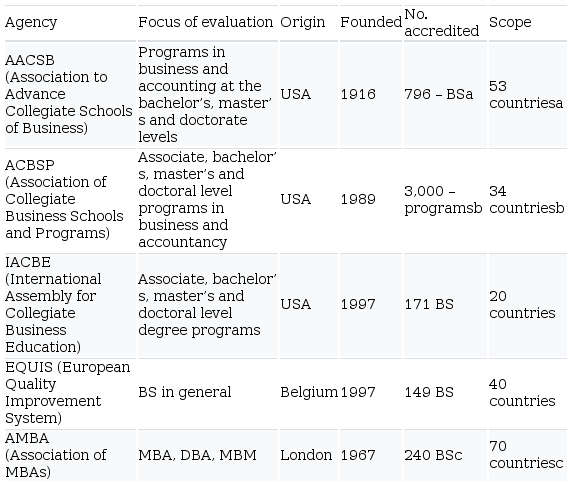
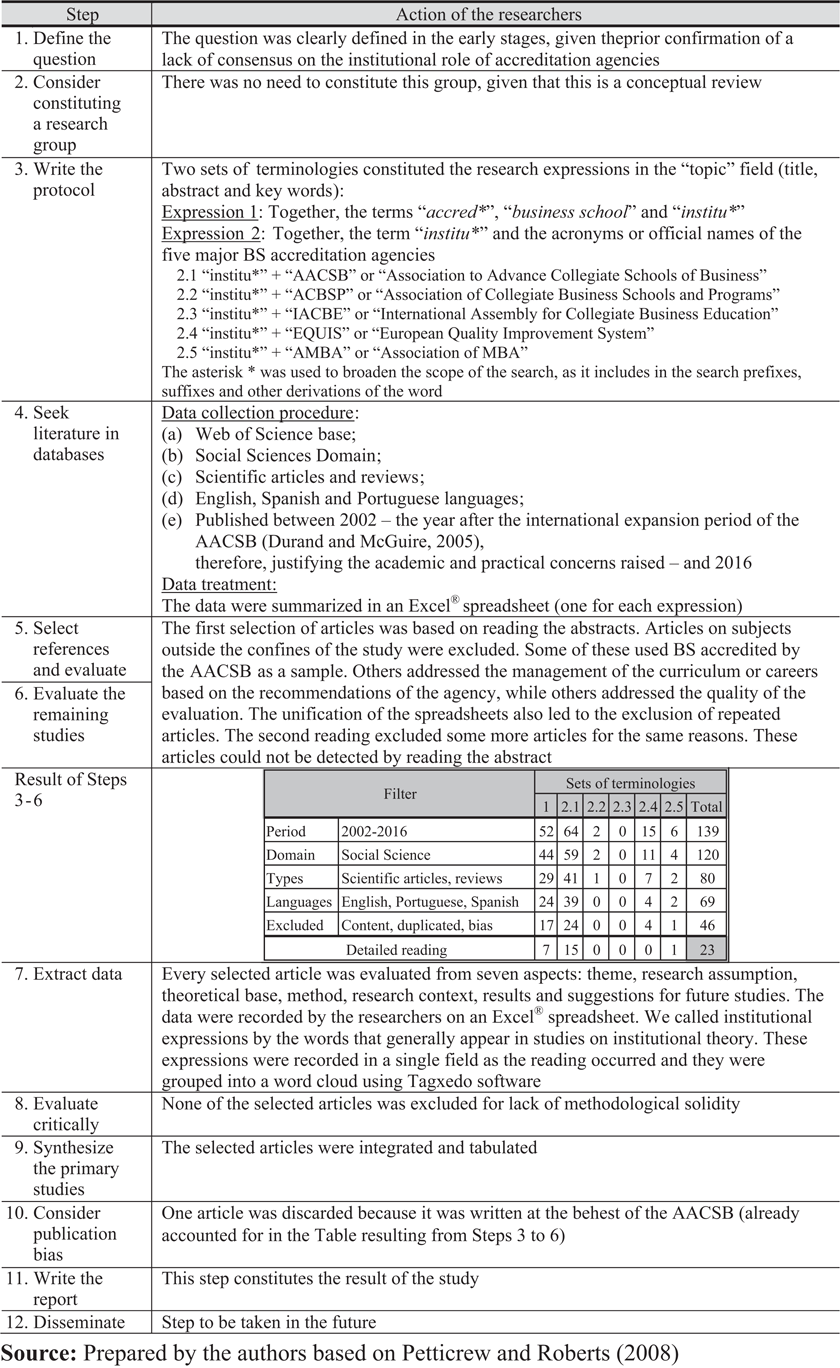
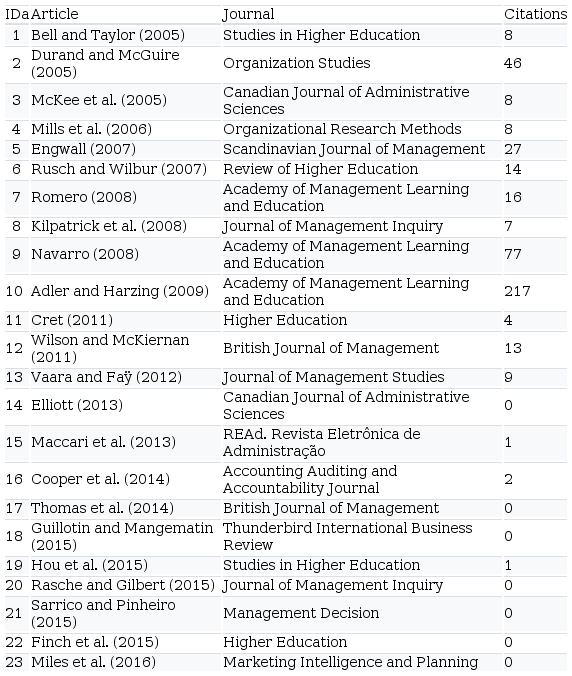
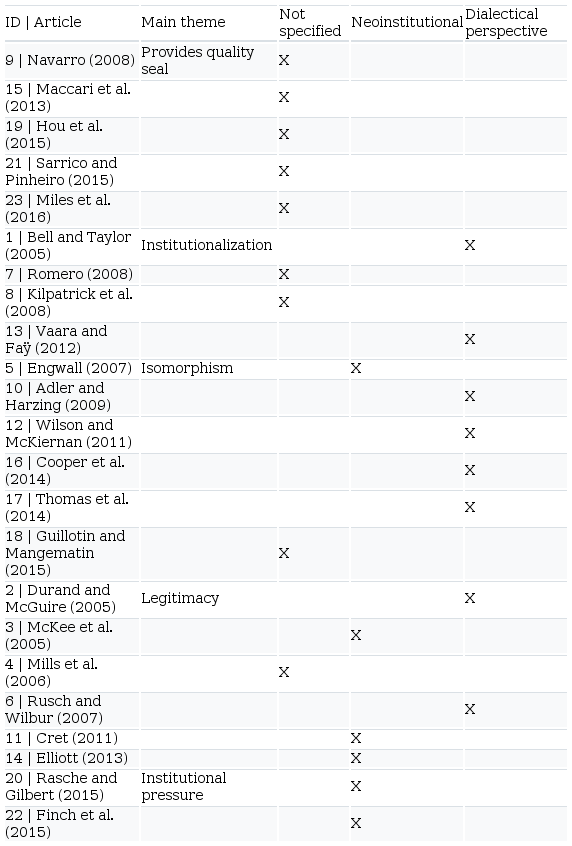
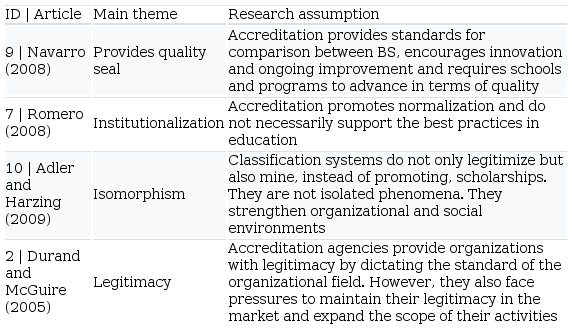

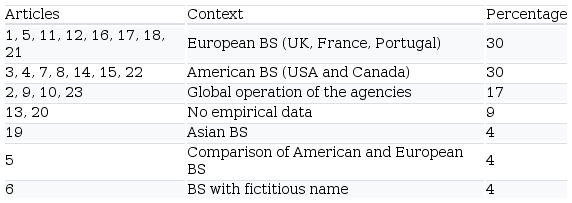
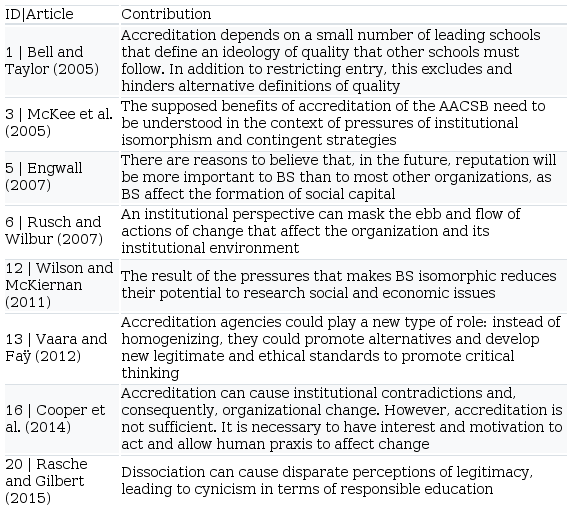
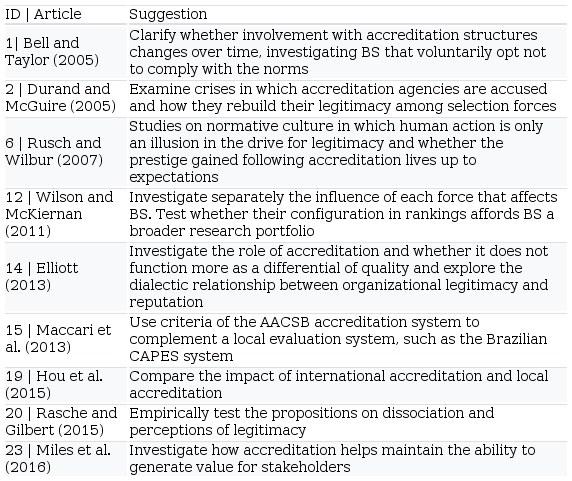
References
AACSB (2017), “Accredited schools”, available at: www.aacsb.edu/accreditation/accredited-members (accessed September 10, 2017).
ACBSP (2017), “About us”, available at: www.mbaworld.com/en/Accreditation.aspx (accessedSeptember 10, 2017).
Adler, N.J. and Harzing, A.W. (2009), “When knowledge wins: transcending the sense and nonsense of academic rankings”, Academy of Management Learning & Education, Vol. 8 No. 1, pp. 72-95.
Alajoutsijärvi, K., Juusola, K. and Siltaoja, M. (2015), “The legitimacy paradox of business schools: losing by gaining?”, Academy of Management Learning & Education, Vol. 14 No. 2, pp. 277-291.
Bell, E. and Taylor (2005), “Joining the club: the ideology of quality and business school badging”, Studies in Higher Education, Vol. 30 No. 3, pp. 239-255.
Bruton, G.D., Ahlstrom, D. and Li, H.L. (2010), “Institutional theory and entrepreneurship: where are we now and where do we need to move in the future?”, Entrepreneurship Theory and Practice, Vol. 34 No. 3, pp. 421-440.
Cooper, S., Parkes, C. and Blewitt, J. (2014), “Can accreditation help a leopard change its spots? Social accountability and stakeholder engagement in business schools”, Accounting, Auditing & Accountability Journal, Vol. 27 No. 2, pp. 234-258.
Council for Higher Education Accreditation (2002), “The fundamentals of accreditation”, available at: www.chea.org/pdf/fund_accred_20ques_02.pdf (accessed June 12, 2016).
Council for Higher Education Accreditation (2015), “Accreditation serving the public interest”, available at: www.chea.org/pdf/chea-at-a-glance_2015.pdf (accessed June 12, 2016).
Cret, B. (2011), “Accreditations as local management tools”, Higher Education, Vol. 61 No. 4, pp. 415-429.
Crubellate, J.M., Grave, P.S. and Mendes, A.A. (2004), “A questão institucional e suas implicações para o pensamento estratégico”, Revista de Administração Contemporânea, Vol. 37, pp. 37-60.
DiMaggio, P. and Powell, W. (1983), “The iron cage revisited: institutional isomorphism and collective rationality in organizational fields”, American Sociological Review, Vol. 48 No. 2, pp. 147-160.
Durand, R. and McGuire, J. (2005), “Legitimating agencies in the face of selection: the case of AACSB”, Organization Studies, Vol. 26 No. 2, pp. 165-196.
Elliott, C. (2013), “The impact of AACSB accreditation: a multiple case study of Canadian university business schools”, Canadian Journal of Administrative Sciences/Revue Canadienne des Sciences de l’Administration, Vol. 30 No. 3, pp. 203-218.
Engwall, L. (2007), “The anatomy of management education”, Scandinavian Journal of Management, Vol. 23 No. 1, pp. 4-35.
Finch, D., Deephouse, D.L., O’Reilly, N., Massie, T. and Hillenbrand, C. (2015), “Follow the leaders? An analysis of convergence and innovation of faculty recruiting practices in US business schools”, Higher Education, Vol. 71 No. 5, pp. 1-19
Gioia, D.A. and Corley, K.G. (2002), “Being good versus looking good: business school rankings and the circean transformation from substance to image”, Academy of Management Learning & Education, Vol. 1 No. 1, pp. 107-120
Greenwood, R., Oliver, C., Sahlin, K. and Suddaby, R. (Eds), (2008), The Sage Handbook of Organizational Institutionalism, Sage, Thousand Oaks, CA.
Guillotin, B. and Mangematin, V. (2015), “Internationalization strategies of business schools: how flat is the world?”, Thunderbird International Business Review, Vol. 57 No. 5, pp. 343-357.
Hall, P.A. and Taylor, R.C. (1996), “Political science and the three new institutionalisms”, Political Studies, Vol. 44 No. 5, pp. 936-957.
Hou, Y.C., Morse, R., Ince, M., Chen, H.J., Chiang, C.L. and Chan, Y. (2015), “Is the Asian quality assurance system for higher education going glonacal? Assessing the impact of three types of program accreditation on Taiwanese universities”, Studies in Higher Education, Vol. 40 No. 1, pp. 83-105.
Istileulova, Y. and Peljhan, D. (2015), “Institutional change as a result of international accreditation: business schools of Lithuania after the iron curtain”, Economic and Business Review for Central and South-Eastern Europe, Vol. 17 No. 3, pp. 291-312.
Kilpatrick, J., Dean, K.L. and Kilpatrick, P. (2008), “Philosophical concerns about interpreting AACSB assurance of learning standards”, Journal of Management Inquiry, Vol. 17 No. 3, pp. 200-212.
Kostova, T., Roth, K. and Dacin, M.T. (2008), “Institutional theory in the study of multinational corporations: a critique and new directions”, Academy of Management Review, Vol. 33 No. 4, pp. 994-1006.
Lawrence, T.B. and Phillips, N. (2004), “From Moby Dick to Free Willy: macro-cultural discourse and institutional entrepreneurship in emerging institutional fields”, Organization, Vol. 11 No. 5, pp. 689-711.
McKee, M.C., Mills, A.J. and Weatherbee, T. (2005), “Institutional field of dreams: exploring the AACSB and the new legitimacy of Canadian business schools”, Canadian Journal of Administrative Sciences/Revue Canadienne des Sciences de l’Administration, Vol. 22 No. 4, pp. 288-301.
Maccari, E.A., Riccio, E.L. and Martins, C.B. (2013), “A influência do sistema de avaliação da AACSB na gestão dos programas de pós-graduação stricto sensu em Administração nos Estados Unidos”, REAd. Revista Eletrônica de Administração (Porto Alegre), Vol. 19 No. 3, pp. 738-766.
MBA Today (2017), “The triple accredited business schools (AACSB, AMBA, EQUIS)”, available at: www.mba.today/guide/triple-accreditation-business-schools (accessed September 7, 2017).
MBA World (2017), “What we do”, available at: www.mbaworld.com/en/Accreditation.aspx(accessed September 10, 2017).
Meyer, H.D. and Rowan, B. (2006), “Institutional analysis and the study of education”, in Meyer, J.W. and Rowan, B. (Eds), The New Institutionalism in Education, Sunny Press, Albany, NY, pp. 1-13.
Meyer, J.W. and Rowan, B. (1977), “Institutionalized organizations: formal structure as myth and ceremony”, American Journal of Sociology, Vol. 83 No. 2, pp. 340-363.
Miles, M.P., Grimmer, M. and Franklin, G.M. (2016), “How well do AACSB, AMBA and EQUIS manage their brands?”, Marketing Intelligence & Planning, Vol. 34 No. 1, pp. 99-116.
Mills, J.H., Weatherbee, T.G. and Colwell, S.R. (2006), “Ethnostatistics and sensemaking making sense of university and business school accreditation and rankings”, Organizational Research Methods, Vol. 9 No. 4, pp. 491-515.
Navarro, P. (2008), “The MBA core curricula of top-ranked US business schools: a study in failure?”, Academy of Management Learning & Education, Vol. 7 No. 1, pp. 108-123.
North, D.C. (1990), Institutions, Institutional Change and Economic Performance, Cambridge University Press, Cambridge.
Oliver, C. (1991), “Strategic responses to institutional processes”, Academy of Management Review, Vol. 16 No. 1, pp. 145-179.
Petticrew, M. and Roberts, H. (2008), Systematic Reviews in the Social Sciences: A Practical Guide, John Wiley & Sons, Malden, MA.
Rasche, A. and Gilbert, D.U. (2015), “Decoupling responsible management education why business schools may not walk their talk”, Journal of Management Inquiry, Vol. 24 No. 3, pp. 239-252.
Romero, E.J. (2008), “AACSB accreditation: addressing faculty concerns”, Academy of Management Learning & Education, Vol. 7 No. 2, pp. 245-255.
Rusch, E.A. and Wilbur, C. (2007), “Shaping institutional environments: the process of becoming legitimate”, The Review of Higher Education, Vol. 30 No. 3, pp. 301-318.
Sarrico, C.S. and Pinheiro, M.M. (2015), “The characteristics of Portuguese management academics and their fit with teaching accreditation standards”, Management Decision, Vol. 53 No. 3, pp. 533-552.
Scott, W.R. (1987), “The adolescence of institutional theory”, Administrative Science Quarterly, Vol. 32, pp. 493-511.
Selznick, P. (1996), “Institucionalism ‘old’ and ‘new’”, Administrative Science Quarterly, Vol. 41, No. 2, pp. 270-277.
Seo, M.G. and Creed, W.D. (2002), “Institutional contradictions, praxis, and institutional change: a dialectical perspective”, Academy of Management Review, Vol. 27 No. 2, pp. 222-247.
The Free Dictionary (2016), “Definition”, available at: www.thefreedictionary.com/accreditation (accessed June 12, 2016).
Thomas, L., Billsberry, J., Ambrosini, V. and Barton, H. (2014), “Convergence and divergence dynamics in British and French business schools: how will the pressure for accreditation influence these dynamics?”, British Journal of Management, Vol. 25 No. 2, pp. 305-319.
Urgel, J. (2007), “EQUIS accreditation: value and benefits for international business schools”, Journal of Management Development, Vol. 26 No. 1, pp. 73-83.
Vaara, E. and Faÿ, E. (2012), “Reproduction and change on the global scale: a Bourdieusian perspective on management education”, Journal of Management Studies, Vol. 49 No. 6, pp. 1023-1051.
Wedlin, L. (2007), “The role of rankings in codifying a business school template: classifications, diffusion and mediated isomorphism in organizational fields”, European Management Review, Vol. 4 No. 1, pp. 24-39.
Wilson, D. and McKiernan, P. (2011), “Global mimicry: putting strategic choice back on the business school agenda”, British Journal of Management, Vol. 22 No. 3, pp. 457-469.
Zammuto, R.F. (2008), “Accreditation and the globalization of business”, Academy of Management Learning & Education, Vol. 7 No. 2, pp. 256-268.
Zhao, J. and Ferran, C. (2016), “Business school accreditation in the changing global marketplace: a comparative study of the agencies and their competitive strategies”, Journal of International Education in Business, Vol. 9 No. 1, pp. 52-69.
Zucker, L.G. (1977), “The role of institutionalization in cultural persistence”, American Sociological Review, Vol. 42, pp. 726-743.
Further reading
Julian, S.D. and Ofori-Dankwa, J.C. (2006), “Is accreditation good for the strategic decision making of traditional business schools?”, Academy of Management Learning & Education, Vol. 5 No. 2, pp. 225-233.

